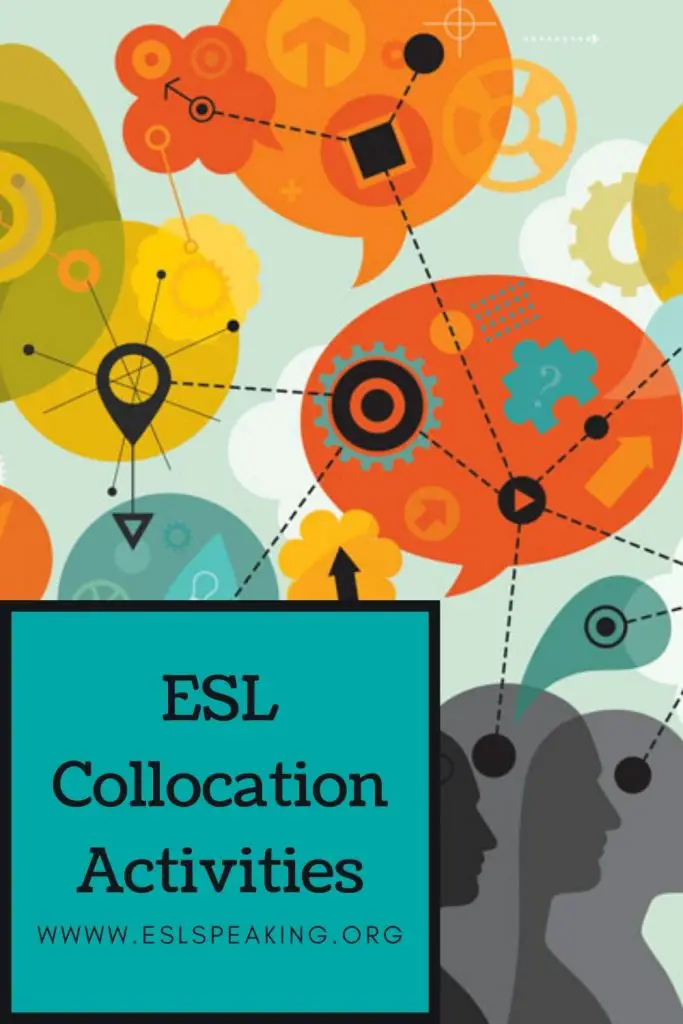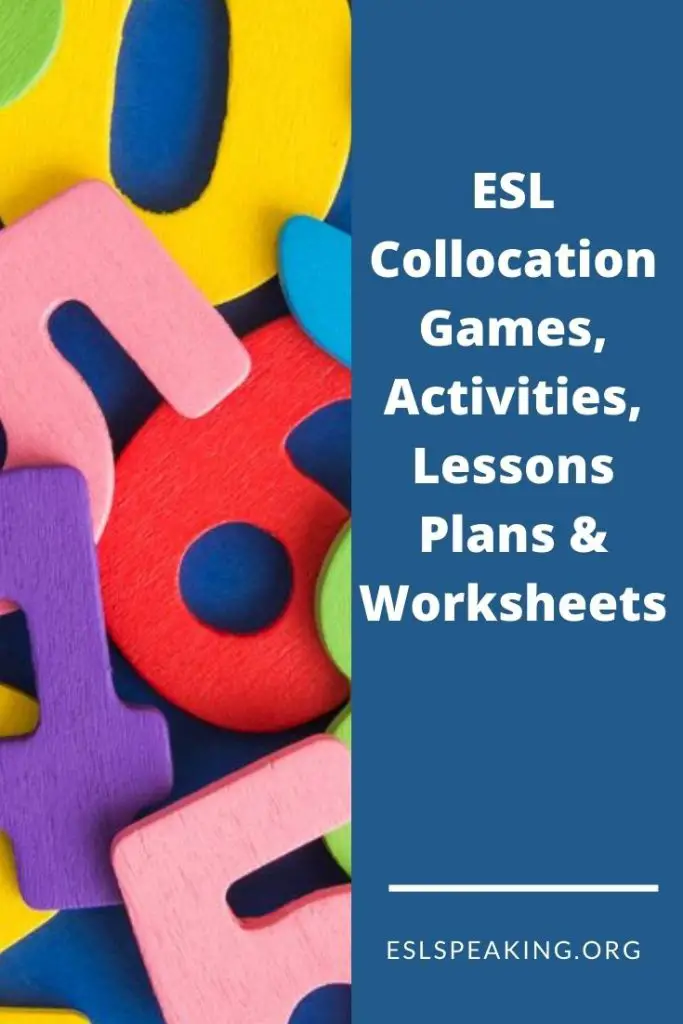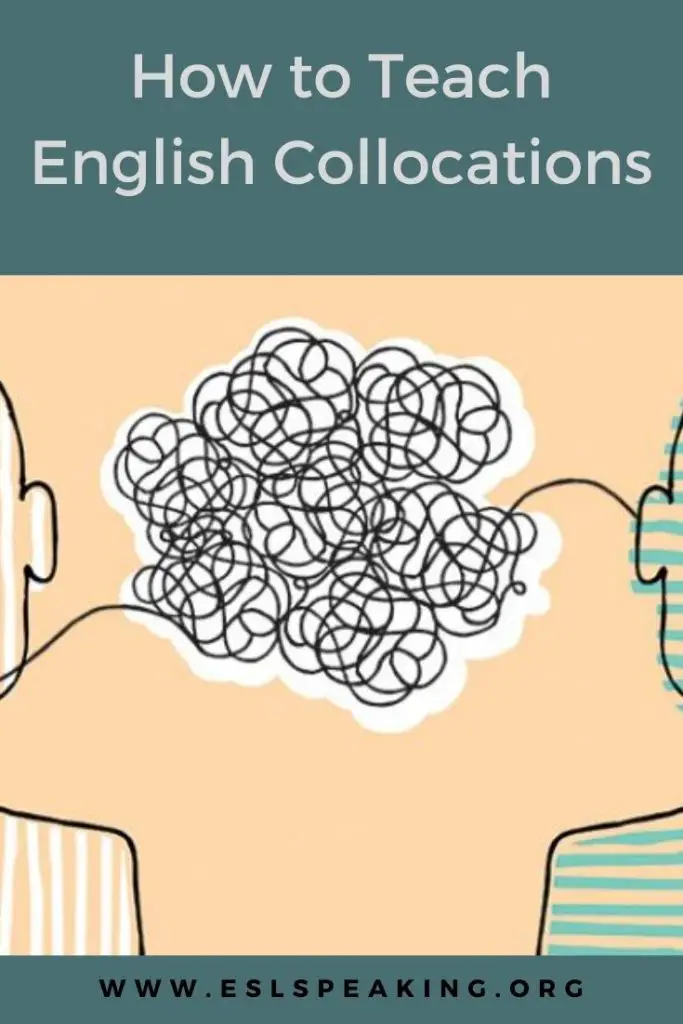If you want to teach ESL collocations in style, then you’re certainly in the right place. We have the best English collocation activities, games, lesson plans, worksheets and other resources to help students learn them quickly and easily.
What is a collocation? Simply put, they are words that occur together with more frequency in the English language than just by random chance. For example, save money, a cup of coffee, pair of scissors, play football, do yoga, etc. There are thousands of them and helping students master them can be the key to moving towards fluency.

ESL Collocation Activities
Teaching Collocations Activities
Let’s get into the best ESL collocation games and activities to try out with your students.
#1: Collocation Running Dictation
This is one of my favourite ESL games. It’s fun, engaging and student-centred. But, the best part is that it can be used for just about any vocabulary set, including collocations.
Find, or write a conversation between two people using lots of the target language. Then, students have to work with a partner to dictate it. After that, they can put the conversation in the correct order. The first team to do this correctly is the winner. Check it out:
#2: English Collocations in Dialogue
- Amazon Kindle Edition
- Bolen, Jackie (Author)
- English (Publication Language)
- 70 Pages - 01/01/2021 (Publication Date)
If you want to help your students work on collocations in a big way, then consider recommending this book to them. It’s ideal for self-study between classes, or even consider picking it up to incorporate into lessons.
The best way to learn English collocations is in dialogue and this book does exactly that. Plus, there’s a vocabulary focus and then an opportunity to get some practice with the new words. Just what students need to level up their TOEIC, TOEFL, or IELTS scores. Check it out here:
#3: ESL Taboo
I’m sure you’ve played this fun party game before. You have to describe a secret word without using a set of related words. I’ve adapted it a little bit to make it easier on the prep time. It’s an ideal review activity for collocations. Try it out:
#4: Vocabulary Auction
This is a fun vocabulary game for all ages that does require some preparation time. However, it’s totally worth it and the students really enjoy it.
Write some sentences filled with the target collocations that you’ve been teaching. Then, cut out each word. In groups, students have to bid on words that they think will help them make complete sentences. After that, there’s some trading time between groups.
Finally, the team with the most complete sentences is the winner. Find out all the details:
#5: Apply Fun ESL Activities with Collocations
#6: Puzzle Finder
Try out this fun TEFL activity to help students learn English collocations. On each piece of the corresponding puzzle, put one half of the collocation.
Students have to circulate around the class to try to find their match. It’s fun, interactive and a nice way to review collocations. Find out more about it here:
#7: Basketball Game Challenge
This is a fun game for kids or teenagers to get some practice with collocations. On the flashcards, use words that lend themselves really easy to collocations such as:
- make
- do
- play
- cup of
- pair of
- etc.
Then, students have to use that word to make a collocation such as:
- make the bed
- do my homework
- play soccer
- cup of coffee
- pair of pants
Find out more about this fun vocabulary game here:
#8: Dictogloss
This is a challenging listening activity that’s ideal for higher-level language learners. Find, or write a passage with a number of the target collocations in it.
Put students into pairs and read it out at quite a fast pace for the level of the students. They have to take notes and then compare them with a partner to try to recreate what they just heard. Repeat the process. Finally, students compare their version with the original one. Learn more about it:
#9: Post-Reading Activities
I love to use some activities after having my students read a passage in order to get the most value out of it. In this case, it could be having students circle things they think are collocations. Find out some more ideas here:
#10: More English Collocations in Dialogue
- Amazon Kindle Edition
- Bolen, Jackie (Author)
- English (Publication Language)
- 147 Pages - 02/24/2021 (Publication Date)
If students want to improve their scores on English proficiency exams like the IELTS test, then learning more vocabulary is certainly one way to do that. It can be very helpful to learn collocations, that is, words that occur more commonly together in the English language than by random chance.
Learning a language in “chunks” like this is a proven way to become fluent. This book helps with exactly that! Find out more about it:
#11: Dialogue Substitution
Maybe your students are kind of like mine. Whenever I ask them to read a dialogue in a textbook with their partner, they just blow through it but don’t really pay that close of attention to what they’re reading. Of course, it’s totally my fault because I haven’t given them a reason to read carefully.
A nice way to turn this exercise into a meaning-focused one as well is to remove some of the key words. In this case, part of the collocation. This pumps up the challenge and turns it into a more fruitful activity. Find out how I do it:
ESL Dialogue Substitution Activity.
#12: Verb Collocations
#13: Picture Prompt
This is a nice ESL warmer activity that can be used to introduce students to any sort of vocabulary. Find a picture that lends itself well to the target collocations. For example, with make, do, or play, you can find a picture of people doing lots of things. Then, elicit from the students what they see:
- playing tennis
- doing yoga
- making breakfast
- etc.
This can lead to a more explicit lesson about collocations. Find out more:
#14: Collocations Concentration
This a simple memory game that works very well for this type of vocabulary. Put the first half of the collocation on one card and the other half on another one. For example:
- make / the bed
- eat / sushi
- watch / a movie
- play / video games
Mix them up and place them face down in an organized fashion. Then, students have to play a collocation matching exercise. Find out more about it here:
https://www.eslactivity.org/concentration-an-esl-vocabulary-game/

ESL Collocations Worksheets & Plans
#15: Collocations and Holidays
There are a ton of English collocations related to the holidays and this can make a nice lesson around Thanksgiving, Christmas, Easter, etc. Here are just a few of the hundreds!
- stuff the turkey
- decorate the tree
- wrap presents
- Easter egg hunt
- put up Christmas lights
- wrap presents
- carve the turkey
- make stuffing
- Easter bunny
Find out the best ideas for holiday lessons right here:
#16: Charades
This is a fun game to use with verb collocations. Students can act out simple phrases like:
- take a shower
- make the bed
- cook dinner
- watch TV
- go to sleep
- etc.
Find out more about how to use this popular game in TEFL classes:
#17: Drilling Activities and Games
Collocations are key to speaking English fluently! One of the keys to helping students remember them is by drilling. Have a look here for some of the best options:
TEFL Drilling Games and Activities.
#18: Collocations Speaking Lesson Plan
It’s quite easy to plan a speaking or conversation lesson for just about anything, including collocations. Have a look here for the steps to follow in this guide:
#19: Collocation Dominoes
Similar to matching cards, create domino pieces with collocations on each end. Students match the words to form chains of correct collocations.
#20: Bingo
Prepare bingo cards with various collocations instead of numbers. Call out definitions, synonyms, or related words, and students mark the corresponding word on their cards.
#21: Role Play
Give students scenarios or dialogues where they need to use these words appropriately. This helps them practice using collocations in context.
#22: Pictionary
Have students draw pictures representing collocations. Their classmates must guess the collocations based on the drawings.
#23: Word Search
Create a word search puzzle with collocations. Students find and circle the collocations within the grid.
#24: Story Building
Give students a list of collocations and have them work in pairs to create a story that incorporates as many of these kinds of words as possible.
ESL Collocations Worksheets
If you’re a teacher, then you already know how much time it can save to use what other teachers have created. Check out sample worksheets to help your class. Let us know if it is helpful.
Teaching Collocations Lesson Plans
Other teachers have already done the heavy lifting! Also, have a look at a sample Collocation ESL lessons. Do you think it is going to help your students’ learning?

How to Teach English Collocations
FAQ About ESL Collocations
Here is a quick guide to some commonly asked questions about teaching and learning ESL collocations.
What is an example of a collocation?
Some examples of collocations are “pay attention”, “take a shower”, and “give birth”.
What are the 7 types of collocations?
The 7 types of collocations are:
- adverb + adjective
- adjective + noun
- noun + noun
- noun + verb
- verb + noun
- verb + expression with preposition
- verb + adverb
What are the most common collocations?
Some of the most common collocations include “make a mess”, “come on”, “have fun”, “catch a cold”, and “go abroad”.
How do you effectively learn collocations?
The most effective way to learn collocations for ESL students is to read dialogues. Reading dialogues helps learn vocabulary, idioms, phrases, and collocations. It is also helpful when taking exams like IETLS, TOEIC, and TOEFL. You can easily find useful collocations worksheets and books to use in your ESL classes.
Have your Say about ESL Collocation Activities
Do you have any ideas for teaching English collocations? Leave a comment below and let us know what you think about it. We’d love to hear from you.
Also, be sure to give this article a share on Facebook, Pinterest, or Twitter. It’ll help other busy English teachers, like yourself, find this useful resource.
Last update on 2025-03-28 / Affiliate links / Images from Amazon Product Advertising API








Leave a Reply